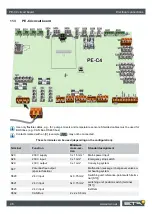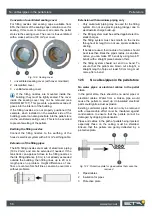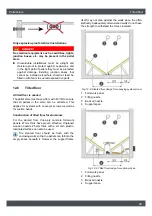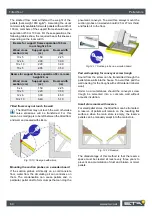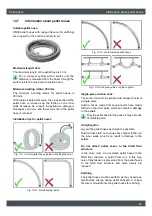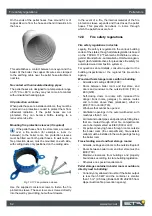
Pellet store
Calculating pellet supply and store size
55
12.3
Calculating pellet supply and
store size
Heating value and bulk weight of pellets
The energy density of 2 kg of pellets corresponds
to that of 1 litre of extra-light heating oil.
Calculating the pellet supply
Rule of thumb for determining the pellet supply in tons:
divide the heating load of the building by 3.
For the pellet supply in cubic metres (m³), divide the
heating load by 2.
Example for the pellet supply for a single-family house
with average insulation and 12 kW heating load:
•
12 kW / 3 -> 4 tons of pellets per year
•
12 kW / 2 -> 6 m³ of pellets per year
The pellet supply can also be calculated from the
current fuel consumption using the appropriate
conversion factors:
Required storeroom size
The required storeroom size is based on the heating
load. Use the rule of thumb "heat load divided by 2" to
find the minimum required storage volume in m³.
Example for the pellet supply for a single-family house
with average insulation and 12 kW heating load:
12 kW / 2 -> 6 m³ of pellets per year
To be prepared for colder winters, the store
should hold around 20% more than a year's
supply. For this example, that means a storage volume
of 7.2 m³ is needed. Using this volume, we can
determine the necessary room dimensions and the
length of the conveying system.
The length of the conveying system needed for the
storage volume can be determined using table
. That length also
determines the minimum length of the storeroom.
Example: Room width 2 m and height 2.4 m:
•
The table shows a usable cross section of 3 m².
The volume of pellets to be stored in the example
above is 7.2 m³:
=> 7.2 m³ / 3 m² = 2.4 m minimum room length
A conveying system with a length of 2.5 m is
required.
Example: room width 2.8 m and height 2.4 m:
•
The table yields a usable cross section of 3.73 m².
The volume of pellets to be stored in the example
above is 7.2 m³:
=> 7.2 m³ / 3.73 m² = 1.93 m minimum room length
A conveying system with 2 m length is required.
The screw conveyor should preferably be
oriented along the room's long axis. This is
because the narrower the storeroom, the less space is
lost under the slanted floor.
The conveying system can also be shorter than the
storeroom. To use the entire room length for the
conveying system, select the next larger length of the
conveying system (see examples above) and shorten
the troughs on site.
Determining the usable storage volume
Due to the required slope, storeroom widths over 3 m
with normal room height yield little to no usable
additional volume. This also applies to conveying
systems with suction probes.
Fig. 12-1: Cross section
The following table is used to determine the usable
cross-section of a storeroom in m² with the conditions
in the illustration above:
•
40° inclined form
•
Free space above 400 mm
Heating value
4.9 kWh/kg
Bulk weight
650 kg/m³
Fuel consumption
Factor
Pellet supply
1960 l heating oil
x 2.04
4000 kg
2060 m³ natural gas
x 1.94
4000 kg
2960 l LPG
x 1.35
4000 kg
1560 kg LPG
x 2.56
4000 kg
2660 kg coke
x 1.50
4000 kg
5700 kWh electricity from
a geothermal energy heat
pump with COP 3.4
x 0.70
4000 kg
9500 kWh electricity from
a ground source heat
pump with COP 2.1
x 0.42
4000 kg
Summary of Contents for PelletsCompact
Page 1: ...2020 07 21 EN 0000000061 V 022 1513 93003 003 PelletsUnit 7 15 kW Installation ...
Page 41: ...Installation Network connection 41 ...
Page 45: ...Electrical connections Overview of circuit boards 45 ...
Page 49: ...Electrical connections PE C4 circuit board 49 ...
Page 66: ...www eta co at ...
Page 67: ......
Page 68: ...www eta co at www eta co at downloads DOWNLOAD ...






